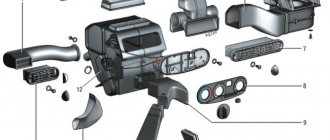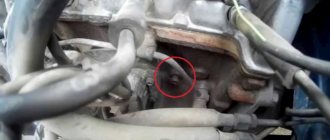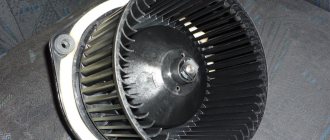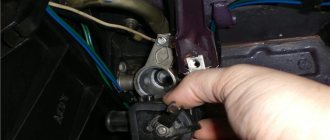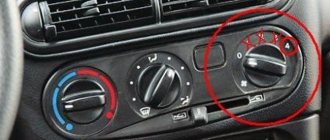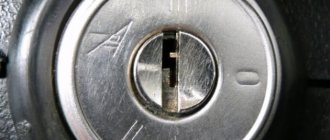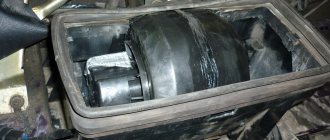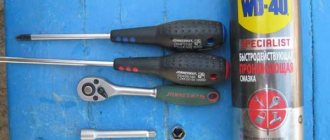Most motorists today are dissatisfied with the operation of the stove on the Chevrolet Niva. There are many complaints: from the build quality of the device to the unsatisfactory functioning of certain parts, one of which is the stove tap. This element can be replaced even in a garage.
- 2 For what reasons is the Chevrolet Niva faucet replaced?
2.1 The principle of installing the stove faucet
- 3.1 Video: how to install a heater tap on a Chevrolet Niva
Causes of poor stove performance
The Chevrolet Niva has a system that simultaneously performs the functions of heating in winter and cooling in summer. This system consists of several components, among which are the radiator, control unit, pump, pipes, tap and others. The failure of any components favors the emergence of a situation in which the car owner begins to claim that the stove on his Niva Chevrolet does not work at all.
In this regard, it is important to understand that the heater will not blow well, even if microcracks appear in the pipes, if the additional or main resistor fails. An excessively dirty radiator can also act as an obstacle to proper heating of the interior.
Algorithm of actions
If there are no problems with resistors, continue to explore other mechanisms
Check the antifreeze level; it is very important that it corresponds to the indicators indicated in the technical documentation for the car. If you detect a lack of coolant, add to the required level
Be sure to check the level again the next day. If you find that the level has dropped again, then you will have to look for the source of the leak. Often the culprit is old pipes that have lost their elasticity. For this reason, small cracks appear on their surface, through which antifreeze easily leaks. By the way, a lack of coolant not only prevents proper heating of the interior, but can also cause serious engine damage. For this reason, it is important to replace leaking pipes in a timely manner.
If the control unit turns out to be problematic, you can only dismantle it. It is unlikely that you will be able to repair it yourself, since this requires you to have the appropriate knowledge, as well as the necessary instruments and devices. For this reason, you will have to use the services of auto repairmen.
It would be a good idea to check the cabin filter, which, if excessively dirty, provokes an increase in current strength, as a result of which the fuses blow. Without them, not a single device powered by electricity can function.
The reason that there is no or very weak heating air entering the interior of your car may be a “clogged” heating system. Experienced car owners recommend flushing the entire system. Such washing will not be superfluous, especially in cases where you purchased your “iron friend” not at a car dealership, but from your own hands. You don’t know what the appeal was to the car, to its technical part before you. You do not have information about what you previously poured into the radiator, or whether you used additional additives. Improper use of chemical components can provoke extremely undesirable consequences.
Do not regret the time spent searching for the cause of the failure. Even if you cannot identify the problem yourself, you will gain excellent practical experience, you will understand how to get to certain components of the car, which will later act as a real priceless treasure for you.
This is interesting: Replacing heater valves on a BMW E34/E39: we do it quickly, accurately and with our own hands
Main stove malfunctions
Stove malfunctions can be very different. The most common reason for its failure is:
- heater valve malfunction;
- damage to radiator pipes;
- failure of the additional resistor;
- radiator damage;
- control unit problems.
As a result of any of the above situations, the stove stops working normally.
Warm air does not enter the lower part of the cabin
Before repairing the stove, you should check the temperature of the coolant (coolant). Perhaps the problem is not in the interior heater, but in the cooling system. If the engine warms up to operating temperature (90˚C), then the cause of the malfunction should be sought in the stove.
With the help of damper position regulators, warm air is directed to different parts of the cabin
The dampers should be adjusted first. To supply hot air to your feet, follow these steps:
- The engine warms up until the warm air can be felt with your hand.
- The heater fan speed switch is set to position 4.
- The airflow direction knob turns to the 12 o'clock position and immediately returns to 10 o'clock. Air should begin to flow into the lower part of the cabin.
- If the result is not achieved, the procedure is repeated.
This sequence of actions is due to assembly errors. Due to gaps and backlashes, interference is created with air distribution and installation of the damper in the desired position the first time. If after these steps the heat still does not reach your feet, the heating system needs to be modified.
Antifreeze leak from the stove
In used cars, coolant often begins to leak from the stove. The reason for this is usually wear and tear on the pipes or a malfunction of the heater tap. Since antifreeze circulates under pressure, all connections must be tight. However, during prolonged use, hoses and gaskets lose their elasticity and burst. After inspecting the heating system and identifying the leak, the worn part is replaced with a new one. When making repairs, you should not use clamps made in China due to their poor quality.
Due to loss of elasticity, the stove pipes crack over time and leak antifreeze.
Coolant can also leak from the heater radiator itself. In this case, it will have to be replaced with a new one.
The stove doesn't heat well
To diagnose the malfunction, turn on the ignition, start the stove and try to change the intensity of the air supply. If at the first three speeds the air is not supplied or is supplied cold, the cause of this is a faulty resistor that needs to be replaced.
The reason for the inability to switch speeds is the failure of the resistor
If the resistor is OK, the diagnosis continues. Check the coolant level. If it is low, add antifreeze to normal and check it after a few days. If the level has noticeably decreased, you should pay attention to the hoses and pipes, wear of which is usually the cause of coolant leakage.
For what reasons is the Chevrolet Niva crane replaced?
The heating valve in the car serves the site, so it is necessary to change it for both technical and financial reasons. If a faucet breaks, it is thrown away, and the causes of the malfunction may be as follows:
- Violation of tightness. When the elements rub, they wear out and therefore no longer fit together as they should. As a result, various smudges appear, which are very noticeable.
- Internal oxidation of elements. In summer, the stove tap is closed for a long time, so during this period its elements oxidize and stick to each other. So, opening the tap without breaking it is almost impossible.
On a Chevrolet Niva, the heating valve for the heater is located in the wall of the engine compartment, so when you open the hood of the car, you will see a pipe that goes to the valve adapters from the radiator.
To get to it, you need to dismantle the torpedo in the cabin on the passenger side.
The stove valve is mounted in a special niche in the engine compartment
If the tap has been replaced, then it is better to install new pipes along with it, because during operation they have probably already lost their elasticity.
The principle of installing the stove tap
Before replacing the heating tap on the stove, you need to perform preliminary work:
- remove the glove box;
- partially drain the coolant.
Antifreeze is drained as follows:
- We carry out all work only on a cooled engine, so as not to accidentally get burned. On the left side under the motor we place a bowl or any other plastic container.
To dismantle the stove tap, you need to drain the antifreeze
- If possible, open the tap as far as possible.
In order to drain the antifreeze, you must fully open the stove valve.
- We prepare a meter-long hose, use a key set to “13” to unscrew the plug on the cylinder block. We substitute the hose and insert one end into the basin.
To drain the coolant, you need to unscrew the plug on the cylinder block
- Lightly hold the hose with your hand and little by little open the cap located on the expansion tank. We do this work carefully, as the stream of antifreeze will gradually increase.
In order to remove the heater valve, it is necessary to completely drain the antifreeze.
- Loosen the clamp on the carburetor heating pipe and remove this part from the fitting.
- After all the coolant has flowed out, screw the plug into the block and tighten it well.
The glove box can be removed by unscrewing all the screws that hold it in place. Some of them are located deep in the part, others - under the tank lid.
Auto parts for foreign cars, auto repair
Step-by-step DIY replacement of the Niva Chevrolet heater fan
First of all, when tightening the pipe onto the flange, the threads on them will turn, which will entail depressurization of the system and subsequent leakage of antifreeze. Blower Motor Located under the dashboard on the passenger side, under the glove box on the left. Operates in four-speed sequential mode.
The adjustment is carried out by switching the mode with a regulator located on the dashboard in the Chevrolet Niva the heater does not work. In addition, you need to check the integrity of the fuse, and if the thread breaks, replace it. If the interior electric fan motor malfunctions, you can remove it by performing the following actions: Control unit The control unit contains heating system mode switches. If it doesn't work, it needs to be replaced.
You can carry out repairs, but in this case you need to understand electrics or entrust the repair to a professional.
Why doesn't the heater work on a Chevrolet Niva? Fix it yourself
Fan If the fan is not working, check the functionality of the electric motor. To repair the fan, it must be removed. The removed device is checked using the battery. If the motor is not working, it must be replaced.
If you can’t buy it, you can try to restore it yourself. True, only in the case when the thermal fuse has blown, naturally, no one will rewind the windings, the game is not worth the candle.
Fan resistor You can remove and check the resistor without dismantling the motor.
This is done like this: Use a Phillips screwdriver with a short blade to unscrew the rightmost screws securing the glove compartment. Unscrew the rightmost screws securing the glove compartment. We gain partial access to the motor, but this is enough to get to the resistor.
Replacement frequency, how much and what kind of fluid is needed
- loss of coolant properties. You can check the quality of the antifreeze used using a test strip, which is sold in the same places where the liquid itself is sold. Place the strip in the expansion tank, then pull it out. The strip comes with a color scale, according to which you can understand how much longer the car can be used before replacing the coolant;
- change in color of the coolant to tan or red. This means that rust has appeared in it;
- the appearance of sediments, flakes and dense formations in the liquid.
The coolant for the VAZ 21214 Niva injector should have a freezing point no higher than -40 degrees. Typically, the manufacturer fills in TOSOL TS-40 (manufacturer in Dzerzhinsk). When replacing antifreeze, it can be replaced with antifreeze with G12 approval; it is safer for the entire cooling system. You can also use original Lada G12 antifreeze, which is suitable for all cars of this manufacturer.
Antifreeze volume table
| Model Niva | Engine capacity | Antifreeze volume | Original/recommended fluid |
| VAZ 21214 | 1.7 | 10.7 | Lada G12, TOSOL TS-40 |
| VAZ 21213 | 1.6-1.7 | 10.7 | |
| VAZ 2121 | 1.4-1.8 | 10.6 | |
| VAZ 2131 | 1.7 | 10.7 |
Do-it-yourself conversion of the stove on Niva 21213
CAUSE
REMEDY METHOD
The operation of the stove on the classic Niva traditionally causes complaints from most owners of this car. A frankly weak but noisy fan and poor design of the air ducts do not warm the interior properly. In addition, the operation of the heater is affected by the operation of the VAZ 2121, 2131 in difficult road conditions.
Read news about the new Niva
- How to connect fog lights via a relay and a button: diagram
- Review of the standard alarm system Niva Chevrolet
- DIY stove conversion in Niva 21213
- Replacing a Chevrolet Niva heater radiator with air conditioning without removing the panel
- Relays and fuses Lada 4×4 (VAZ 21214, 21314) » Lada.Online || Niva 21213 low beam power button
- How to use a transfer case in a field, box design || Switching the transfer case in the field from a button
- How to change the light bulbs on the instrument panel of a Niva Chevrolet: video
- How to use locks and lowering correctly. Niva and differential lock
| Wires are damaged or wire connections are oxidized | Check and restore connections. Replace damaged wires |
| Fuse 1 in the fuse block has blown | Replace the fuse |
| The heater switch is damaged - no voltage is supplied to the switch output terminals | Check the switch, replace it with a new one if necessary |
| Sticking or wear of the motor brushes, a break in the armature winding or contamination of the commutator | Check motor, repair or replace |
| Short circuit to ground in the armature winding - when the electric motor is turned on, the fuse burns out | Replace the motor |
| Wires are damaged or wire connections are oxidized | Replace damaged wires, strip wire ends |
| Damaged heater switch | Replace the switch |
| Additional resistor burnt out | Replace the resistor |
| Additional resistor burnt out | Clean the commutator, replace the brushes |
| Contamination or oxidation of the commutator, worn brushes | Replace the motor |
| Interturn short circuit in the armature winding | Disassemble the electric motor, clean the shaft journals |
Why do you need to change the faucet?
In Niva cars, as in classic Zhiguli models, the heating intensity of the interior is controlled using a special tap. It is installed on the coolant supply pipe leading to the heater radiator. The stove tap is made in such a way as to open and shut off the flow in just half a turn of the rod. Thanks to this, the faucet can be controlled using a rod attached to a lever on the center console.
In reality, no one uses the heater valve as a regulator; more often it is used to cut off the heater from the Niva engine in the summer. This is where the following problems arise:
If you do not shut off the fluid flow in the summer, then the interior of the VAZ-21213 will become very hot. In the Chevrolet Niva, the faucet is missing as a weak link, and the stove is constantly heating up. The design of a regular Niva is not designed for this and the problem needs to be solved somehow.
The situation is the same in the other two cases, and due to a leak, harmful antifreeze vapors will accumulate inside the car. Since the design of the heater valve does not provide for its repair, the part only needs to be replaced.
This is interesting: Replacing the rear axle gearbox seal of a VAZ 2107
Types of radiators
Radiators are made from two types of materials: copper and aluminum. Each has its own pros and cons. An aluminum radiator heats up quickly, is inexpensive and has good rigidity with low weight. However, such a device cannot be repaired, since it is very problematic to solder it. Aluminum also does not retain heat well, so it cools quickly.
Copper radiators are more expensive, but have their own positive characteristics:
- Unlike aluminum ones, they last longer because copper does not corrode.
- They maintain the set temperature for a long time, despite the fact that they heat up slowly. In the Niva SUV, the stove requires heating more space than in conventional sedans. This is why you should choose a high-quality radiator.
The downside of a copper radiator is one thing: acquiring parts of acceptable quality is not very easy. A copper device is more expensive than an aluminum one. Its price is in the range of 2000–2500 rubles.
What is a stove tap, its functional features and location
The stove tap is a metal part that resembles a regular water tap. Antifreeze (coolant or coolant) constantly flows through it.
In the Chevrolet Niva, the coolant can flow through 2 cooling circles: winter and summer. The heating tap gives the driver the opportunity to switch to one of them. For example, with the onset of summer, when the tap is fully open, it is almost unbearable to be inside the car due to the heat, so it is closed for this period of time, and with the onset of cold weather, the tap is opened again. Due to active use, the part eventually becomes unusable and leaks coolant.
It is very easy to determine whether a part is faulty - lift the cover in the Chevrolet Niva interior. If there are obvious signs of leakage, the unit must be replaced.
In the diagram you can see where the heater tap is located and the circulation of antifreeze in two circles
It is best to replace the metal faucet of the stove with a ceramic one, which will increase its service life several times.
Useful tips
There are a number of points to consider when replacing a heating tap.
- It is quite difficult to find an original faucet for sale for a Chevrolet Niva car that is not of high quality.
- Most car owners install cranes manufactured by LUZAR. At the same time, preference is given not to metal, but to ceramic products, which are considered more reliable. The cost of such a crane ranges from 500 to 900 rubles.
The heater valve produced by LUZAR is considered the most reliable - In exceptional cases, it is possible to install a three-way sanitary tap DN15 in place of the heating tap. Its internal flow diameter is 15 mm - this is enough for normal circulation of antifreeze. However, due to design features, it is impossible to attach a rod to the DN15 tap, which allows you to change the coolant circulation circles directly from the car interior. Therefore, to change the heating mode you will have to open the hood.
In exceptional cases, you can use a DN15 sanitary tap - It is recommended to apply a thin layer of high temperature sealant to the sealing plate prior to installation. This will greatly reduce the risk of coolant leakage. High-quality sealants are produced by ABRO. The cost of one tube, depending on the volume, ranges from 300 to 500 rubles.
ABRO high temperature sealant will reduce the risk of coolant leakage - You need to remove the fastening pin on the faucet clamp very carefully, as it is quite fragile. If removed carelessly, a piece of the cotter pin may get stuck in the clamp . It won't be easy to get him out of there.
Thus, replacing the interior heating system tap on a Chevrolet Niva car is quite simple. Even an inexperienced car enthusiast can do this with a standard set of tools and one hour of free time.
Copywriter with five years of experience. (2 votes, average: 1 out of 5)
Source
What to put in place
Before rushing to the store for a new part, you should first disassemble the assembly and make sure that the faucet is to blame for all the troubles. It often happens that the seal between it and the heater radiator, where the rubber gaskets are located, leaks. They become limp and begin to leak coolant. The cause of jamming may be the rod attached to the element.
Also interesting: Soundproofing the Niva: advice from the experts
Faucets made of metal or ceramic are available for sale. In terms of price, they are approximately the same; in terms of reliability, motorists praise ceramic ones more. In addition, you need to purchase 2 new gaskets and high-temperature sealant (usually red).
For reliability, some VAZ-21213 owners prefer to install a regular plumbing faucet with a diameter of 15 mm (DN 15), connecting it to the stove with flexible pipes. The option is reliable, since plumbing fittings are more durable than car parts. But then it’s better to forget about convenient controls, because every time you have to dive under the glove box on the front passenger side to open or close the valve. It is also installed on the engine side, under the hood, resulting in the same “conveniences”.
Factory (standard), ball or ceramic valve, which is better?
Among car owners on various forums, discussions constantly arise about which heater tap is better. Most often, battles unfold between two options: ball or ceramic. Almost no one doubts that a standard valve based on a rubber membrane is not reliable, more often than others it leaks, “sticks” and is especially susceptible to acidification. As proof of this, see the images above, where the reason for the replacement is a jammed faucet and a fluid leak.
Ball or ceramic?
Ceramic heater tap
A ball valve, in principle, is also not bad; the undoubted advantage of such a valve is its greater throughput compared to a ceramic one (when open, the passage hole is equal to the internal diameter of the pipe). At low temperatures this is especially noticeable, but the likelihood of souring is higher for a ball valve than for a ceramic one.
Preparatory stage
To change the heater tap, you need to perform 2 preliminary operations: partially drain the coolant and remove the glove box.
Antifreeze is drained in the following sequence:
- The operation is carried out on a cooled engine to avoid burns. Under the engine on the left side (in the direction of movement) you need to place a basin or a cut plastic canister.
- Fully open the stove tap (if possible).
- Having prepared a 1 m long hose, unscrew the plug on the cylinder block (key 13), move it to the side and place the hose directed into the basin.
- Hold the hose and smoothly open the expansion tank cap. Be careful as the antifreeze stream will become larger.
- Loosen the clamp of the carburetor heating pipe or the injector throttle valve block and remove it from the fitting.
- When the fluid has drained, screw the plug back into the block and tighten.
The glove box is removed by unscrewing several screws holding it in place. Some of them are located immediately under the glove compartment lid, the other part is in the depths of the box.
The main reasons why the Chevrolet Niva stove does not work and how to eliminate them
With the onset of cold weather, it is important that the car interior is heated, creating comfortable conditions for the driver and passengers. The article discusses cases when the stove of a Niva Chevrolet car does not work, the main malfunctions, and describes how to repair the unit
Car heating system
The Chevrolet Niva SUV has a heating system that not only heats the interior in winter, but also cools it in summer.
Its design includes:
- Control block;
- radiator;
- coolant pump;
- pipes;
- evaporator;
- tap;
- compressor.
In addition, the design has a resistor and a fuse that are responsible for functionality.
Possible faults
Various problems with the Chevrolet Niva are possible: the heater blows cold air, the fan may not work, etc.
The cause of the problem may be the following:
- The stove tap does not work;
- radiator pipes are damaged;
- the additional resistor does not function;
- radiator is faulty;
- The control unit does not work.
To restore the functionality of the system, you need to know how to troubleshoot problems and repair faulty elements or replace them.
How to fix a resistor?
Before repairing a resistor, you need to make sure that it is inoperative. To do this, you need to turn on the ignition and check its operation - how the air will blow. This device is responsible for the operation of the fan, or more precisely, its rotation frequency. If the fan does not work in the first three speed positions, then the device is faulty.
To change the resistor, you need to pull the glove compartment forward without removing it. Disconnect the wiring harness. Next, remove the device and install a new part. After the process is completed, you should check the operation of the fan at different speeds (author - Andre Vladimirovich).
How to change the tap and pipes?
Over time, due to wear and tear, the pipes become unusable and the heater valve leaks. The stove pipe is replaced if it is leaking. If the faucet is faulty, it should be replaced. It is better to replace it with a ceramic product; they last longer than the standard ones. It is recommended to change the pipes along with the tap: over time, they lose elasticity and may leak.
Control block
The control unit contains switches for heating system modes. If it doesn't work, it needs to be replaced. To do this, you need to dismantle the device and replace it with a new one. You can carry out repairs, but in this case you need to understand electrics or entrust the repair to a professional.
Fan
If the fan is not working, check the functionality of the electric motor. Using this device, air is pumped into the interior of the car. To repair the fan, it must be removed. The removed device is checked using the battery. If the motor is not working, it must be replaced. You can completely replace the entire device by purchasing a new device in advance.
Replacing the heater (radiator)
Replacement is carried out if antifreeze begins to leak. The radiator is located behind the glove box, in a niche on the left side of the front passenger's feet.
The procedure includes the following steps:
- First, turn off the on-board network by disconnecting the negative terminal from the battery.
- Then you need to remove the glove compartment and side panel.
- Drain the antifreeze from the block.
- Next, unscrew the air duct blowing on the legs so that it does not interfere with removing the parts.
- Then remove the cabin air filter.
- Having unscrewed the snail, we move the damper body to the side. Then you should disconnect the wires, and take out the volute and motor.
- Next, unscrew the evaporator screws and disconnect the hose. Moving the evaporator to the side and gently pressing it to the floor, remove the device.
- Then disconnect the pipes. If there are new pipes, the old ones can be cut off.
- After unscrewing the two fastening screws, remove the heater radiator from the niche.
- We install a new device. Assembly is carried out in reverse order.
- Add coolant.
After replacing the radiator, you need to check the functionality of the stove.
Replacement frequency, how much and what kind of fluid is needed
- loss of coolant properties. You can check the quality of the antifreeze used using a test strip, which is sold in the same places where the liquid itself is sold. Place the strip in the expansion tank, then pull it out. The strip comes with a color scale, according to which you can understand how much longer the car can be used before replacing the coolant;
- change in color of the coolant to tan or red. This means that rust has appeared in it;
- the appearance of sediments, flakes and dense formations in the liquid.
The coolant for the VAZ 21214 Niva injector should have a freezing point no higher than -40 degrees. Typically, the manufacturer fills in TOSOL TS-40 (manufacturer in Dzerzhinsk). When replacing antifreeze, it can be replaced with antifreeze with G12 approval; it is safer for the entire cooling system. You can also use original Lada G12 antifreeze, which is suitable for all cars of this manufacturer.
Antifreeze volume table
| Model Niva | Engine capacity | Antifreeze volume | Original/recommended fluid |
| VAZ 21214 | 1.7 | 10.7 | Lada G12, TOSOL TS-40 |
| VAZ 21213 | 1.6-1.7 | 10.7 | |
| VAZ 2121 | 1.4-1.8 | 10.6 | |
| VAZ 2131 | 1.7 | 10.7 |
Additional block under the glove box
| Number | What is he responsible for? |
| 1 | Additional relay (turns on the right electric fan through an additional resistor at low rotation speed) |
| 2 | Fuse (50A) protecting the power circuits of the additional relay and the right electric fan relay |
| 3 | Fuse for the fuel pump (fuel pump) (15A), protecting the power circuits of the electric fuel pump relay |
| 4 | Fuse (15A) protecting the controller's constant power supply circuit |
| 5 | Right electric fan relay |
| 6 | Left electric fan relay |
| 7 | Fuel pump relay |
| 8 | Main relay |
| 9 | Fuse (50A) protecting the left electric fan circuits |
| 10 | Fuse (15A) protecting power circuits switched on by the main relay |
| 11 | Controller |
Procedure for installing a new part
Due to the fact that the heater radiator is located above the engine, part of the coolant does not flow out of it when it is emptied. And even more so it is full when the old tap is stuck closed. So before disassembling the unit, you need to stock up on a plastic bag without holes: it is convenient to place it in places with limited access.
Also interesting: Bleeding Chevrolet Niva brakes: step-by-step instructions
Disassembly and removal of the tap are carried out in the following order:
- From the engine compartment, you need to loosen the clamps of the pipes leading into the cabin, and then remove them from the fittings.
- Unscrew the screws holding the sealing gasket (key 8) and remove it.
- From the interior of the Niva, you need to get to the tap and disconnect the rod by unscrewing the clamping bolt (key 7). Place a plastic bag to catch the remaining antifreeze.
- Loosen the bolts securing the faucet to the stove (key 10), unscrew them and pull out the part along with the metal pipe. If the heater radiator is copper, of the old type, then instead of bolts there will be nuts.
- Separate the metal pipe from the old faucet by unscrewing 2 nuts (10 wrench). Remove the traction mount from it.
The rod mount and pipe must be installed on the new element using fresh gaskets coated with sealant. Then the crane is mounted in place and the unit is reassembled.
Taking this opportunity, it wouldn’t hurt to check the tightness of the connection of the second pipe to the radiator and, if necessary, change the gaskets there. It is also recommended to install new clamps on the hoses.
To avoid air locks when filling the system with liquid, you need to fill it slowly until antifreeze flows from the carburetor heating pipe. In this case, the heater valve must be open.
When disassembling the heater, a large number of tree leaves and insect remains were found in the air intake casing and in the honeycombs of the heater radiator grille, which also reduced the efficiency of the heater. Therefore, after cleaning and flushing the heater core, I took measures to prevent the radiator from clogging.
To do this, I bent a wire frame to the size of the air intake inlet, covered it with a nylon mesh with a 1x1 mm cell, and installed it at the bottom of the rubber seal of the air intake inlet. It was perfectly fixed there in the fold, like an accordion, without additional fastening.
All work to modify the heater took me about 4 hours of time and did not cost a penny of additional costs. Unfortunately, during work I didn’t think to take a photo, but from the attached drawing and picture everything should be clear. I'm happy with the result, now the stove heats better.
Replacing the stove fan
Replacing a heater motor is quite simple.
Required Tools
To work you will need:
- set of hex keys;
- Phillips screwdriver;
- new electric heater motor.
Removing the stove fan
The stove fan is removed as follows.
- The negative terminal of the battery is disconnected.
- On the right (in the direction of travel) under the windshield there is a cabin filter protected by a snap-on lid. After removing the cover and removing the filter, access to the heater fan is available. To access the heater fan, the cabin filter is removed
- The impeller is removed. To do this, use a Phillips screwdriver to unscrew the bolt holding the mounting bracket. The impeller moves to the side and is removed. To remove the impeller, you need to unscrew the bolt and remove the mounting bracket
- In the cabin, in front of the passenger seat, the fastening of the glove compartment panel is unscrewed. To access the electric motor, the glove box panel is removed
- The connector with the power wires is disconnected. To remove the electric motor, you must disconnect the connector with the power wires
- Use a short 10mm hex to unscrew the mounting bolts and remove the electric motor. The heater motor is secured with three bolts
- After removing the engine, the impeller is carefully removed through the cabin filter niche. The impeller can be pulled out freely from the cabin filter side
Installing a stove fan
The faulty electric motor is repaired or replaced with a new one. A damaged impeller should also be replaced. A thin wire is threaded through the holes in its body and the cavity of the cabin filter is secured. The impeller must be installed in such a way that the groove located inside it fits into the pin of the electric motor shaft.
Before installing a new engine, the axle is lubricated with a special lubricant.
Assembly is performed in reverse order. If the impeller does not fit into place, it should be moved several times in different directions until it is completely seated on the motor shaft. Then, under the hood, the wire is cut with wire cutters, the mounting bracket is installed and the bolt is tightened. New heater fan installed.
Thus, diagnosing faults, repairing and replacing the heater fan on a Chevrolet Niva is not very difficult. This will require a minimum set of standard tools. Keep an eye on the stove, and the inside of your car will always be warm.
Interior heater repair
The stove in the Chevrolet Niva is considered one of the most reliable components of the car. However, it can sometimes fail.
Replacing the heater cable
Sometimes it is not possible to change the position of the heater damper. The reason for this is a broken cable. To replace it, you will need a standard set of tools and a headlamp. Replacing the cable is carried out as follows.
- The driver's seat moves back.
- The handles are removed from the damper control panel and the screws are unscrewed.
- The panel is dismantled on the left side at the location of the driver's feet. To access the cable you will need to remove the heater control mechanism
- The cable fastening latches are removed.
- The recirculation damper mechanism is dismantled and the cable is removed.
- A new cable is installed. Each end must be twisted into a ring and securely fixed. Using a cable, the position of the air supply flap is changed
- Assembly is carried out in reverse order.
- The functionality of the mechanism is checked.
Replacing the interior heating control unit
A faulty control unit can also cause the interior heating system to not operate correctly. Its dismantling, necessary for repair or replacement, requires the following procedure.
- The negative terminal is disconnected from the battery.
- All handles are removed from the heater control mechanism. To do this, you need to carefully pull them towards you. All handles are removed from the heater control mechanism
- Use a flat-head screwdriver to remove the air circulation lever. Use a flat screwdriver to remove the air circulation lever
- Use a screwdriver to pry up and then remove the block lining. Use a screwdriver to pry up and then remove the block lining
- Under the cladding, use a Phillips screwdriver to unscrew two self-tapping screws. Two self-tapping screws are unscrewed under the cladding
- The control unit is removed.
- Remove the connector with the wires going to the speed switch.
- The block of wires that provide illumination of the unit is disconnected. The connector with wires is removed from the control unit
- If there is an air conditioner, all hoses coming from the vacuum switch are disconnected.
- Use a screwdriver to remove the bracket holding the damper cable braid and other similar elements.
- All rods are disconnected from the control unit.
- A new or repaired device is installed in the reverse order.
After dismantling, the control unit is repaired or replaced with a new one.
Replacing stove pipes
If a coolant leak is detected, the pipes along with the clamps should be replaced. The work is performed in the following sequence:
- The coolant is drained from the system.
- The screws securing the glove compartment are unscrewed and it is removed.
- Use a Phillips screwdriver to unscrew the clamp of the lower pipe. The hose is removed carefully - the antifreeze should not get on exposed skin. If difficulties arise, the pipe should be rotated around its axis.
- The second pipe is removed in the same way.
- New hoses are installed and tightened with clamps. If antifreeze leaks, the stove pipes are replaced with new ones.
Video: dismantling the stove pipes on a Chevrolet Niva
Replacing the stove fan
If the fan does not turn on or if strange noises appear when it is turned on, then the electric motor is most likely faulty.
The most common reasons for its failure are:
- Lack of voltage on the electric motor due to poor contact.
- Visible damage to the motor wires due to chafing.
- The 25 A fan fuse located in the fuse box number F18 has failed.
- Failure of one of the resistors, manifested in the absence of one of the speed modes.
- No ignition.
- Deterioration of the armature and brushes of an electric motor as a result of long-term continuous operation.
If the electric motor malfunctions, it will need to be dismantled.
In any of the above situations, the electric motor will need to be removed.
Heating system fan repair
To diagnose a malfunction, the electric motor is connected directly to the battery. If it works, the problem should be looked for elsewhere. Otherwise, the electric motor is removed for repair or replacement. It is located under the glove compartment panel in the cabin. After dismantling, the electric motor is disassembled and inspected.
The heater motor may not work due to internal contamination.
The design of the electric motor is quite simple. The reason for its stopping may be contamination, wear-out of the armature, bushings or brushes.
The cause of failure of the electric motor may be wear out of the brushes or armature.
The electric motor is cleaned and reinstalled or replaced with a new one.
Heater radiator repair
The main signs of a malfunctioning heater radiator are as follows:
- Coolant accumulates under the floor mat on the driver's side;
- there is a smell of coolant in the cabin;
- when heated, a greasy film forms on the glass, which cannot be washed off with water;
- the stove does not heat the interior well;
- The coolant level in the expansion tank decreases.
If any of the signs are detected, the stove is diagnosed, based on the results of which a decision is made to repair or replace the radiator. More often, car owners install a new radiator. In this case, the system is completely freed from coolant.
When the heater radiator fails, it is usually replaced
Replacing a radiator on a car with air conditioning is a rather complex process that requires special equipment and appropriate skills.
Video: replacing a heating system radiator
Repair and replacement of stove tap
The need to repair the stove tap arises when a leak appears or it is impossible to close or open it completely. The fact is that in the summer the tap is closed, and its elements stick to each other. When you try to turn it off, the tap breaks. Usually it is replaced with a new one.
If the stove valve fails, replace it with a new one.
The tap is replaced as follows:
- When the engine has cooled down and the heater tap is fully open, the coolant is drained.
- The traction cable and glove compartment are removed. To remove the traction cable, use an open-end wrench to loosen the nuts
- The clamps securing the pipes are loosened and removed.
- The tap is removed.
When replacing, it is recommended to install a ceramic faucet with an extended service life. The cost of such a product is within 900 rubles.
The device of the stove of the Niva Chevrolet car
The Chevrolet Niva is equipped with a liquid-type heater. It supplies warm air to the cabin and cools the engine, overheating of which can lead to disastrous consequences and costly repairs.
Without air conditioning
The Chevrolet Niva heating system consists of the following elements:
- ventilation duct;
- windshield heating duct;
- intermediate body;
- air intake filter;
- fan;
- interior heating duct;
- foot heating duct;
- heater radiator.
The intensity of the hot air supply is regulated using dampers. The air duct system distributes the heat flow to various areas of the cabin: windshield, side windows, legs, doors, etc. In addition, there is a four-speed air supply switch.
Heating system for the interior of a Chevrolet Niva car, where 1 is the side deflector air duct; 2 — windshield air duct; 3 - intermediate body; 4 - intermediate air duct; 5 — outside air filter housing; 6 — fan housing of the heating and ventilation system; 7 — central deflector; 8 — air duct for blowing the front passenger’s feet; 9 — facing of control units; 10 — front air duct for blowing the legs of rear seat passengers; 11 — rear air duct for blowing the legs of rear seat passengers; 12 — heater assembly; 13 — air duct for blowing the driver’s feet; 14 - side deflector
With air conditioning
The air conditioning system allows you to regulate the temperature and humidity in the cabin. Before turning on the air conditioner, the heater fan is turned on, and the temperature control knob is set to minimum. Almost the entire air conditioning system is located in the engine compartment. Only the evaporator is brought into the cabin between the heater and the electric motor, providing heat exchange between the incoming air and the refrigerant.
Heater and air conditioner diagram, where 1 - heater housing; 2 — inlet pipe of the heater radiator; 3 — heater radiator outlet pipe; 4 — air conditioner evaporator housing; 5 — evaporator outlet pipe; 6 — evaporator inlet pipe; 7 — fan housing; 8 — control cable for the external air supply damper
As the refrigerant moves through the evaporator tubes, it absorbs heat and turns into a gaseous state. The evaporator fins are cooled, and the fan directs cold air into the cabin and reduces the temperature. Gaseous refrigerant from the compressor under pressure enters the condenser, cools and turns into a liquid state. After this, the liquid is supplied to the receiver, and from it to the evaporator reducer, where it again turns into a gaseous state. A new cycle begins.
LADA 4×URBAN Niva air conditioner and heater with cabin filter.
You will need: flathead and Phillips screwdrivers.
Also interesting: Niva tuning for off-road use from a professional
1. Remove the window handle: remove the latch by prying it with a screwdriver between the latch and the washer.
2. Remove the door handle: take out the plug, prying it off with a screwdriver, and then unscrew the three fastening screws.
3. Remove the inner handle trim: pry it off with a screwdriver.
4. Remove the door trim (depending on the configuration and year of manufacture):
- Unclip the 8 plastic clips around the perimeter (two on each side and four on the bottom).
- Unscrew the door trim fastening screws around the perimeter (phillips screwdriver).
There are slight differences in the process of dismantling the door trim of the new model (different door handle and location of fastening screws).
Procedure:
- Remove the door handle: take out the plug, prying it off with a screwdriver, and then unscrew the two fastening screws.
- Remove the inner handle trim: pry it off with a screwdriver.
- (For rear door trim) Remove the window handle: remove the latch by prying it with a screwdriver between the latch and the washer.
- Unscrew the door lock.
- Unscrew the screws securing the casing (4 on top under the plugs and 3 on the bottom).
- Remove the door trim by unclipping the rivets around the perimeter.
Step-by-step procedure for dismantling the stove motor
The stove motor is not so easy to get to!
Before we begin dismantling the stove, we prepare all the necessary tools and make sure that the key is not inserted into the ignition switch. To make it easier to dismantle the stove motor, the manufacturer recommends dismantling the entire dashboard, along with the instrument panel, wiring and other fasteners, followed by their dismantling and removal from the interior. However, we consider this method to be too long and not rational, because it is much simpler and easier to dismantle the motor simply by looking from below
However, we consider this method to be too long and not rational, because it is much simpler and easier to dismantle the motor simply by looking from below
To make it easier to dismantle the stove motor, the manufacturer recommends dismantling the entire dashboard, along with the instrument panel, wiring and other fasteners, followed by their dismantling and removal from the interior. However, we consider this method to be too long and not rational, because it is much simpler and easier to dismantle the motor simply by looking from below.
- So, to do this, we dismantle the glove compartment, otherwise there is no way to get the engine out of the seat.
When dismantling, we must be careful.
Remove the air duct on the right side and the power plug on the motor body itself. Next, using a Phillips screwdriver, unscrew the three screws connecting the motor to the impeller.
Then, using long flat screwdrivers, insert them in the center and separate them from each other
(When carrying out this work, pay special attention to the position of the pulley stopper and the impeller, because it can simply fly out - approx.). Or, if you do not want to disconnect the motor from the impeller, you can unscrew the four screws in the air intake and remove the entire assembly
Or, if you do not want to disconnect the motor from the impeller, you can unscrew the four screws in the air intake and remove the entire assembly.
Next, we remove the entire structure and begin to inspect it.
Inspection of the stove motor and replacement
We inspect the motor and impeller for damage.
Depending on the presence of certain malfunctions, the stove motor may need:
- Cleaning and blowing the impeller from dirt and dust.
- Lubricate all moving parts to avoid heat and unnecessary friction.
- Replacement of power wires or rubber pipe.
In order to diagnose the condition of the motor, you just need to bring its terminals (red and black wires directly to the battery - approx.). And if the motor is working, it will turn on at maximum power.

